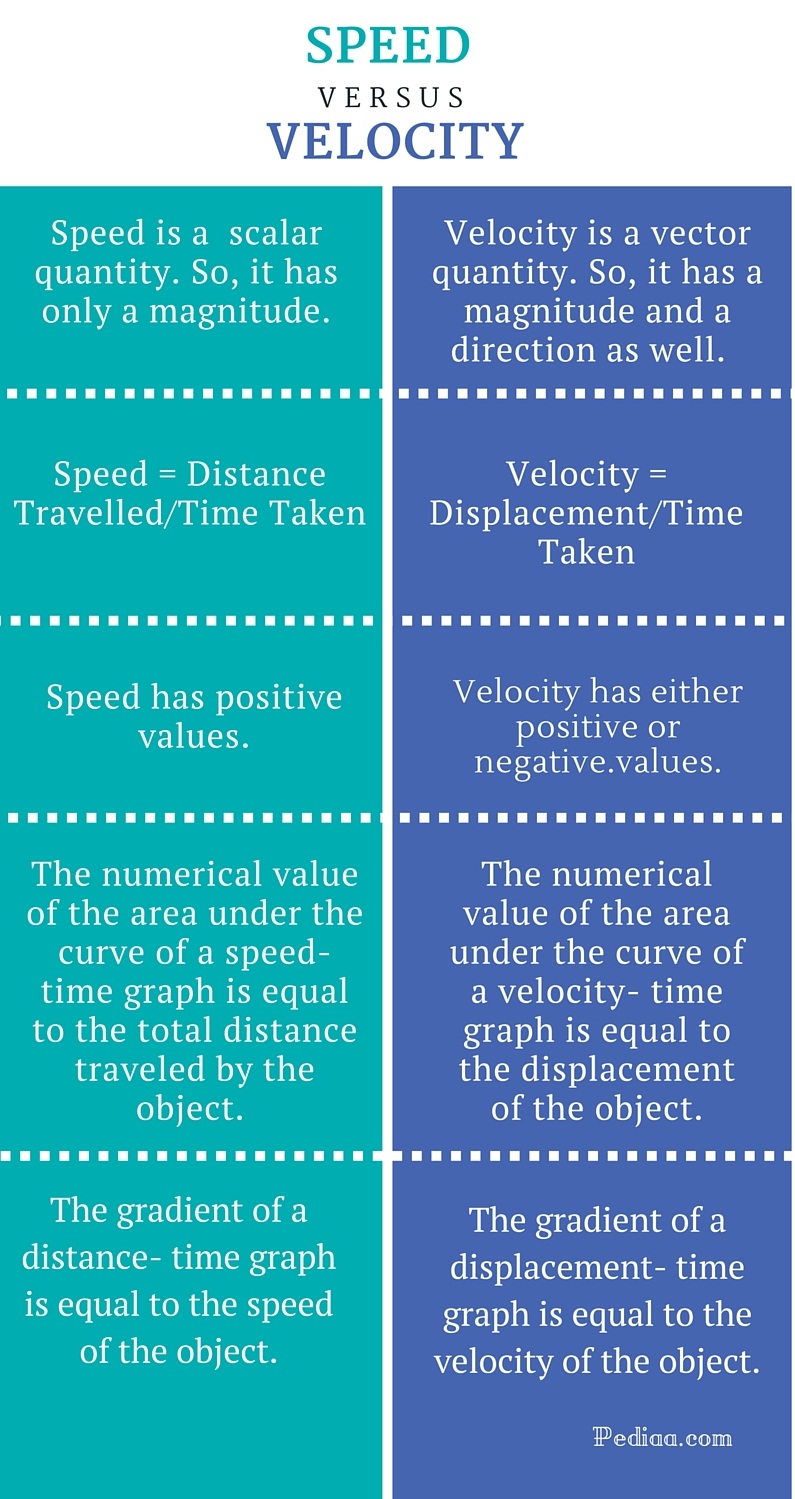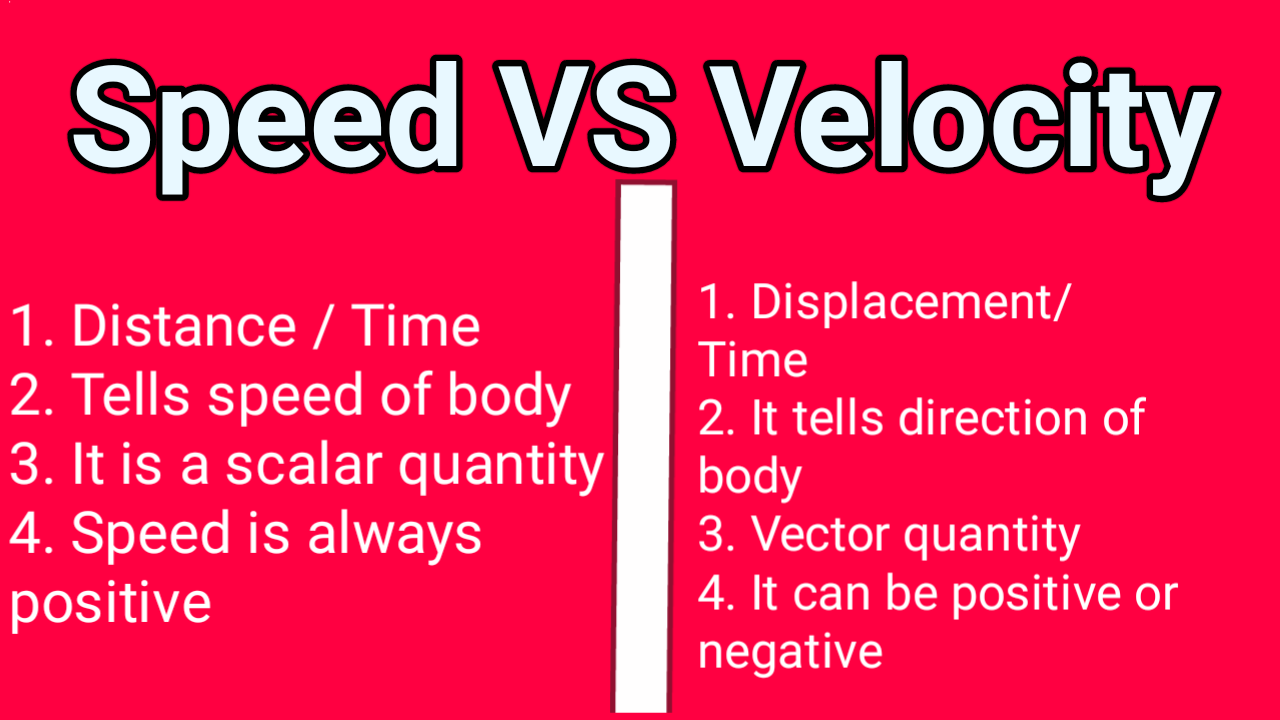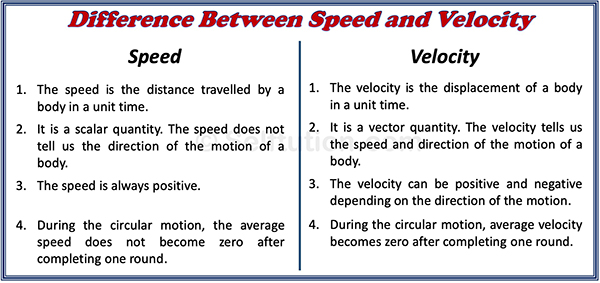what is the difference between speed and velocity

Have you ever wondered about the difference between speed and velocity? Many people use these terms interchangeably, but they actually have distinct meanings in the world of physics.
Difference Between Speed and Velocity

The main difference between speed and velocity is the inclusion of direction. Speed measures how fast an object is moving, without any regard to the direction of the movement. Velocity, on the other hand, includes both the speed and the direction of the movement. For example, if you were driving a car at 60 miles per hour, that would be your speed. But if you were driving north at 60 miles per hour, that would be your velocity.
Difference Between Speed, Velocity and Acceleration

Acceleration is another term that is often used alongside speed and velocity. Acceleration refers to the rate at which an object’s velocity changes. It can either be positive (when the object is speeding up) or negative (when the object is slowing down). For example, when you press on the gas pedal of a car, you are causing it to accelerate because the car’s velocity is increasing. On the other hand, when you hit the brakes, you are causing the car to decelerate because the velocity is decreasing.
Examples of Speed and Velocity
Let’s take a look at some examples to better understand the difference between speed and velocity. Imagine you are running on a treadmill that is set to 6 miles per hour. Your speed would be 6 miles per hour, because that is how fast you are moving. However, if the treadmill is moving in the opposite direction that you are running, your velocity would be 0 miles per hour. This is because even though you are moving, you are not making any progress in any particular direction.
Another example is a plane flying at 500 miles per hour from east to west. The speed of the plane is 500 miles per hour, but its velocity is 500 miles per hour to the west. If the wind is blowing from the west to the east at 50 miles per hour, the plane’s speed would still be 500 miles per hour, but its velocity would be 450 miles per hour to the west. This is because the wind is slowing the plane down, so it is not traveling at its full velocity.
Abstract
The concepts of speed, velocity, and acceleration are crucial in the field of physics. While these terms are often used interchangeably in everyday language, they have distinct meanings in the world of science. Understanding the difference between speed and velocity is important in many areas, from transportation to sports to engineering.
Introduction
When it comes to describing the movement of objects, the terms speed and velocity are often used. While these words might seem interchangeable, they actually have different meanings. In this article, we will explore the difference between speed and velocity, as well as the related concept of acceleration. We will provide examples and illustrations to help you better understand these concepts.
Content
Speed is a measure of how fast an object is moving, regardless of the direction of that movement. It is typically represented by a unit of distance per unit of time, such as miles per hour or meters per second. For example, if a car is traveling at 60 miles per hour, that is its speed. If the car has a speedometer, it will display this number.
Velocity, on the other hand, is a measure of both speed and direction. It tells us how fast an object is moving in a specific direction. Velocity is represented by a unit of distance per unit of time, with a direction attached. For example, if a car is traveling at 60 miles per hour northwards, that is its velocity. In addition to telling us how fast the car is moving, this also lets us know which way the car is going.
There are many situations where the distinction between speed and velocity is important. For example, in aviation, pilots need to know the velocity of the plane in order to navigate correctly. A plane’s speed might be constant, but its velocity can change depending on factors like wind direction and altitude. Similarly, in sports like soccer and basketball, players need to be able to control the direction of the ball in addition to its speed. In engineering, velocity is a crucial parameter in the design of machines and structures like bridges.
Acceleration is another important concept that relates to speed and velocity. Acceleration is a measure of how quickly an object’s velocity changes. It can be positive, negative, or zero. Positive acceleration means that an object is speeding up, while negative acceleration means that it is slowing down. Zero acceleration means that an object is maintaining a constant velocity.
Acceleration is measured in units of distance per time squared, such as meters per second squared or feet per second squared. For example, if a car goes from 0 to 60 miles per hour in 5 seconds, its acceleration is 12 miles per hour per second. This means that the car’s velocity is increasing by 12 miles per hour every second.
There are many factors that can affect acceleration, including the force applied to an object and the object’s mass. For example, if you push a shopping cart with a certain amount of force, it will accelerate at a certain rate. If you were to push a heavier cart with the same force, it would accelerate more slowly because of its greater mass.
Conclusion
Speed, velocity, and acceleration are all important concepts in the field of physics. While these terms might seem similar, they each have distinct meanings and uses. Understanding the difference between speed and velocity is crucial in many areas of science, from transportation to sports to engineering. By applying these concepts, we can better understand how objects move and interact with one another in the world around us.

Source image : www.bzuscience.com

Source image : pediaa.com

Source image : selftution.com






